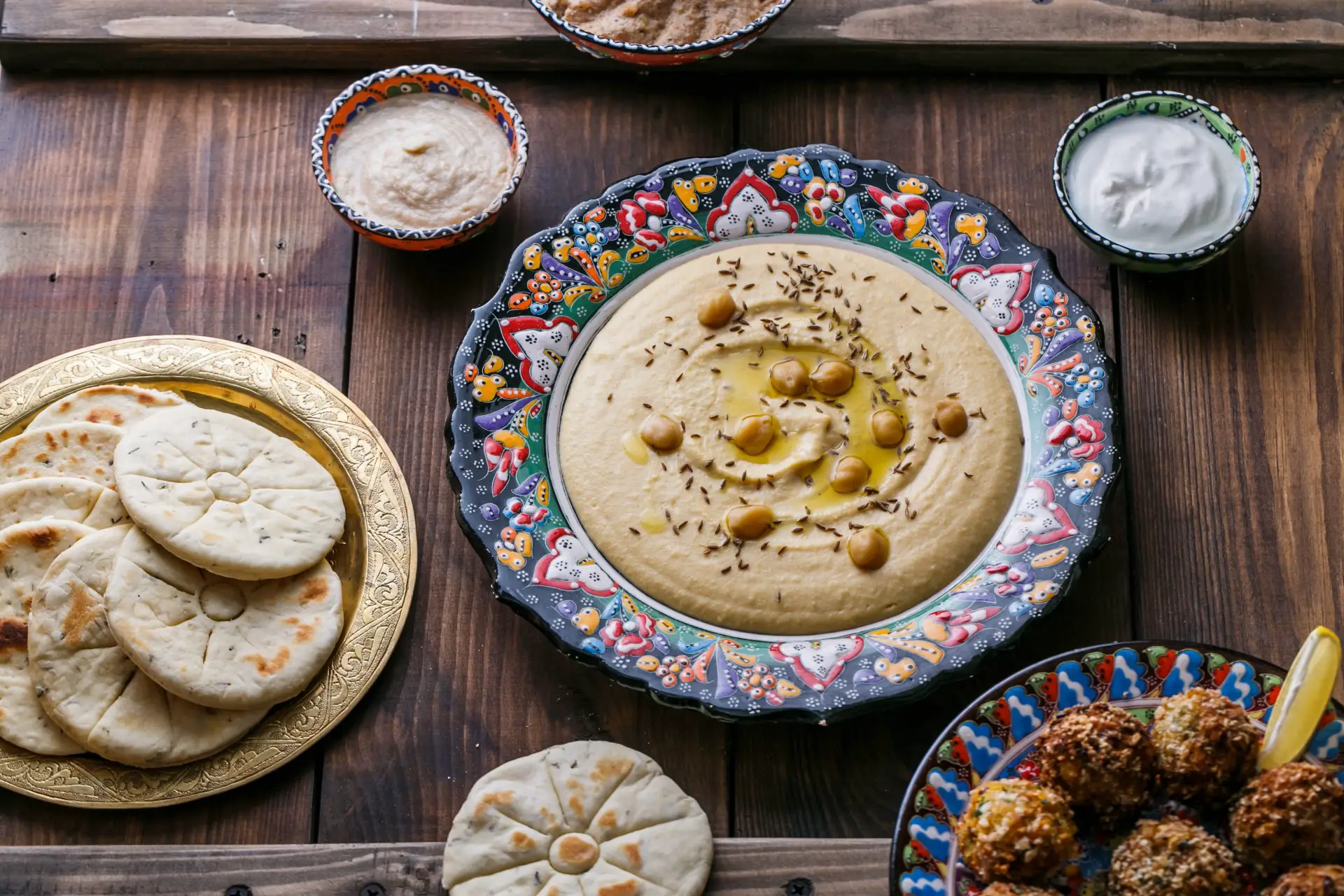Jordan is a melting pot of cultures and the cuisine reflects this deliciously. You can trace the influence of Jordanian dishes from the Levant, the Middle East, Persia, the Mediterranean, and North Africa. Hummus and falafel are barely scraping the surface of the depths of Jordanian fare.
When it comes to the cuisine of the Levant, Lebanon and Palestine tend to get all of the recognition. Traditional Jordanian food can absolutely hold its own with the best of its neighbors, and I highly recommend sampling as much as possible during your next trip to Jordan.
Jordanian food is heavily spiced but not spicy in terms of heat, so most stomachs should be able to handle the cuisine. Za’atar spice blends are ubiquitous and contain a local herb called sumac (from an entirely different plant than poison sumac).
Mansaf

Mansaf is the undisputed national dish of Jordan. Almost every Jordanian you run into will tell you that mansaf is hands down their favorite traditional Jordanian food.
This dish is rice and lamb marinated in dried yogurt powder, and has a very distinct and hearty flavor that I would describe as savory and a tad sour. It’s a very filling and satisfying meal, so don’t plan on hiking the trails at Petra after eating some mansaf.
Falafel
Mezze, or starters/appetizers are integral to Jordanian culture. You’ve probably tried several before such as hummus and falafel, but Jordanians take appetizers to the next level.
Jordanian falafel is hot, fresh, and divine. A traditional falafel ball in Jordan is made of chickpeas (of course) but has a bright green tinge from all of the fresh spices packed in there. Everyone has a different recipe but it’s not uncommon to see parsley, scallions, cumin, coriander/cilantro, and even mint sometimes.
Hummus & Fattet Hummus
I hope if you are reading about Jordanian food you know about hummus already. Jordanian (like most countries in the Levant) claims to have the best hummus and/or to have invented the dish. When Jordanians tell me this I nod politely and agree, of course.
Jordanians do their own variation called fattet hummus which is something like a layered dip consisting of pita, hummus, tahini sauce, pine nuts, and chopped herbs.
Moutabel
Moutabel is very similar to baba ghanoush with one major difference: tahini. Delicious tahini.
The flavor tends to be a bit spicier than the baba ghanoush we have in the States, but the creamy eggplant flavor still makes this amazing with hot freshly baked pita bread.
Labneh
Labneh… it’s like if cream cheese and yogurt had a baby. A heavenly yogurt baby. It’s made by straining whole milk yogurt over and over again with muslin cloth until the whey is removed and the texture is silky smooth. Serve with olive oil, a pinch of za’atar, and pita bread.
Ful
Bean lovers, please try ful. Sometimes spelled foul, which it absolutely is not. Jordanians love this fava bean based dish for breakfast, which has the consistency of refried beans but with generous heaping of olive oil on top. Exquisite!
Manakish

Do you like pita bread? Do you like spices? You’ll like manakish.
Travelers call manakish something like an Arabic pizza. The dish consists of warm pita bread topped with za’atar spices, cheese, and sometimes meat or spinach.
Maqluba

Maqluba was my favorite dish I tried the whole time I was in Jordan. This delicacy is prepared by cooking meat, rice, and veggies together in a pot and then flipping the whole thing upside down right before serving. I’m sure you can imagine the juiciness that ensues afterwards.
Zarb
Zarb is a traditional Bedouin dish prepared by burying meat and veggies in the sand and letting it roast all day in an underground oven. Yes, the food is protected from the sand, and yes, it’s absolutely delicious. Imagine the chariness of barbeque with the soft tender texture of slow cooking.
I wrote about zarb in another post about my time in Wadi Rum. It’s a fascinating process. I even found a YouTube video someone recorded of the preparation.
Knafe
If you’re in the mood for dessert, knafe is mandatory! It was so good that my crown popped off during eating and I didn’t even notice. That’s still an endorsement, I just had a terrible dentist back home. As a side note, Jordanian dentists are incredible.
Anyways, back to dessert… Knafe is a dish made with thin crispy semolina pastry strands layered with sweet cheese, clotted creams, and fresh nuts, then soaked in syrup or rosewater. I wish rose water was more common in the States, I love the subtle flowery herbal taste.
Jordanians love knafe so much that you will see crowded sweet shops open until late in the night. Many even eat dessert with a side of Arabic coffee!
Check out Habibah desserts or Rainbow Street if you are in Amman with a serious sweet tooth.
Food safety
I wouldn’t be too worried about catching a food-borne illness in Jordan, but as always when traveling, be aware of how your food is prepared. I would be cautious of the water in Jordan, and most restaurants you visit will provide you with still or sparkling bottled water.
Use common sense when it comes to food and don’t eat any raw meat. Tread cautiously with raw fruit and vegetables you can’t peel and dairy that might be unpasteurized. Be cautious of ice in drinks as this is the only way I’ve ever gotten a food borne illness!
You can read more on the CDC’s website about food safety while traveling. However, don’t let fear of an illness stop you from eating adventurously! With proper precaution you can have a wonderful time.
Thanks for reading this roundup of food to try in Jordan! If you recommend anything else or discover anything, please leave a comment and send a pic! I would love to talk more about Jordanian cuisine.
Pin it:





Leave a reply